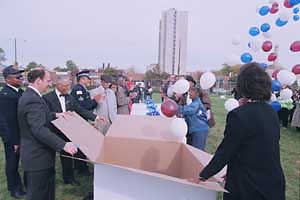University, Woodlawn residents kick off expansion of policing
By Peter SchulerNews Office
 Hank Webber, Vice President of Community Affairs (at left in foreground), releases balloons with the help of community leaders, police officers and residents of the Woodlawn neighborhood, including Rudolph Nimocks, Executive Director of the University Police Department (at Webber’s left). The crowd, which gathered at the South Side YMCA, celebrated the beginning of the University Police Department’s expanded police patrols in the Woodlawn neighborhood, south of the Midway Plaisance. |
Monday marked a significant development in the University’s ongoing cooperation with residents who live in its surrounding neighborhoods. At 12:01 a.m. on Monday, Oct. 15, University Police, in partnership with the Chicago Police Department, began patrolling the north half of Woodlawn, authorized by a City Council resolution that passed Wednesday, Oct. 3.
University police have extended their patrols from 61st Street on the south boundary of the Midway Plaisance to 64th Street in an area bounded by Stony Island Avenue to the east and Evans Avenue (one block west of Cottage Grove Avenue) to the west.
The initiative is the culmination of more than a year of discussions among 20th Ward Alderman Arenda Troutman, whose ward includes Woodlawn; community leaders, including the Rev. Leon Finney Jr. of The Woodlawn Organization; Bishop Arthur Brazier, Chairman of the Board of the Woodlawn Preservation and Investment Corp. and Pastor of the Apostolic Church of God; Rudolph Nimocks, Executive Director of the University Police Department; and Chicago Police Superintendent Terry Hillard.
Troutman praised all the parties who forged the agreement. “We salute Superintendent Hillard and his team, as well as the University Administration, for their diligence in pursuing an accord that augments and reinforces the valiant mission of both police departments. They will intensify the real security within our neighborhood and diminish the perception of danger and festering fear.”
The Woodlawn community and police leaders formally announced the cooperative undertaking at the Harris YWCA, on Monday, Oct. 15. A motorcade through Woodlawn and the release of 500 balloons in the west field of the South Side YMCA kicked off the initiative.
Troutman led a June meeting at which the plan was shared and approved by more than 300 Woodlawn residents. Troutman, Finney, Brazier and leaders of the two police forces all strongly endorsed the partnership between University Police and Chicago Police to help make Woodlawn safer. “This is a truly historic moment for Woodlawn and the University, who are now working partners in the critical task to make our community safe for our families,” Finney said.
“The Chicago Police Department has had an excellent relationship with the University for many years––not only with the University Police but also with the entire University community. I am confident that this new partnership in the Woodlawn neighborhood will be a success that will benefit everyone involved,” said Hillard.
For more than 40 years, the two police organizations have successfully patrolled the Hyde Park and South Kenwood neighborhoods, north of the University’s campus, from 47th to 60th streets and from Cottage Grove Avenue to Lake Shore Drive.
The University police have developed a package of services that includes “Umbrella Coverage,” in which University Police will escort residents to their destinations; delivery of jumper cables to stranded motorists; bicycle registration to deter theft and facilitate recovery; house watch, in which special police attention is paid to an unoccupied home at a resident’s request; the loan of engraving tools to identify personal property; “Operation Whistle Stop,” which alerts community residents and the police to crime when a whistle is heard; and a victim and witness advocacy program offered in conjunction with the South East Chicago Commission that includes transportation to and from court and explanation of court proceedings.
“We supplement the Chicago Police Department, who already do an excellent job for the neighborhood,” explained Nimocks, a lifelong resident of the Woodlawn community who served 33 years with the Chicago Police Department. “We strongly believe in ëcommunity-oriented policing,’ which means we react very quickly to calls––from two to three minutes on average, and we pay very close attention to the needs of the community.
“When a resident in one of our joint patrol areas asks 911 for help, that call is monitored by both the City of Chicago and University Police departments. We share information immediately and we work together as a team to respond to emergencies.”
Officers of the University Police Department train to the same standards as the Chicago Police Department, and like the CPD, the University Police Department operates 24 hours a day, seven days a week.
![[Chronicle]](/images/small-header.gif)